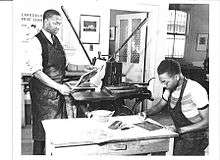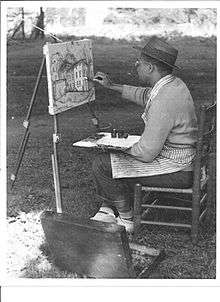Claude Clark
| Claude Clark | |
|---|---|
|
Claude Clark in earlier years | |
| Born |
November 11, 1915 Rockingham, Georgia |
| Died |
April 21, 2001 (aged 85) Oakland, California |
| Nationality | United States |
| Education |
Philadelphia Museum School of Art, Certificate, 1935-39 Studies at Barnes Foundation, Merion, PA, Fellowship, 1939-44 Sacramento State University, B.A. 1958 University of California, Berkeley, CA, M.A., 1962 |
| Known for | Painting, Black Studies Curriculum, West Coast Black Arts Movement |
| Notable work | Resting, Guttersnipe, Rain, Freedom Morning, Raising the Cross, Black Arts Perspective, A Black Teachers Guide to a Black Visual Arts Curriculum |
| Spouse(s) | Diama (Effie) Lockhart Clark |
| Website |
www |
Claude Clark (November 11, 1915 - April 21, 2001) was an African American painter, printmaker and art educator. Clark’s subject matter was the diaspora of African American culture, including dance scenes, street urchins, marine life, landscapes, and religious and political satire images executed primarily with a palette knife.
Early life
Claude Clark was born on a tenant farm in Rockingham, Georgia November 11, 1915. In early August 1923, Clark’s parents left the south for a better life in Philadelphia, Pennsylvania during the Great Migration. Clark attended Roxborough High School[1] where he wrote poetry but also discovered a talent for painting. His Sunday School teacher encouraged him to exhibit in Sunday school class and at church.[2]
Clark studied at the Philadelphia Museum of Art (1935-1939) following high school graduation. He applied to and was eventually accepted to the Barnes Foundation in 1939.[1]
In 1941, Claude met the daughter of an African Methodist Episcopal Church minister, Effie May Lockhart from California. They married in June 1943[1] and formed a dynamic “power” partnership in art, education and philosophy.[3] He continued his paint studies at The Barnes Foundation while teaching art in the Philadelphia Public School system during the early years of their marriage. The couple moved to Alabama and finally California while continuing their careers.

During the Great Depression Clark contacted the Artists Union for work through the Works Progress Administration (WPA). He worked with the WPA from 1939 – 1942. Clark joined the graphics art shop where he worked with Raymond Seth and Dox Thrash.[1]
Clark was the subject of many articles and publications. He also was the author of A Black Art Perspective, a Black Teachers Guide to a Black Visual Arts Curriculum, Merritt Press 1970. As a member of the Black West Coast Arts Movement he co-developed the first African American Studies curriculum. He also mentored and supported many young emerging scholars and artists.[4]
Education

Claude Clark attended high school in Philadelphia, PA, graduating from Roxborough High School. From 1935 - 1939, Clark studied at the Philadelphia Museum School of Industrial Art (later the Philadelphia Museum of Art on full scholarship. While studying there, he came across the work of Van Gogh. Van Gogh's style and method formed the basis of Clark's approach to drawing and painting, with thick creamy texture and loosely applied paint using a palette knife.[1]
In 1939 Clark applied to the Barnes Foundation in Merion, Pennsylvania and was accepted. Clark studied at Barnes from 1939 – 1944. The Albert Barnes collection consisted of an array of works that included African art, European Impressionism and American art. He was able to investigate the hundreds of original “old masters” and modernist works and to study first hand one of the first important collections of African art in America.
While studying at Barnes in 1939, Clark found a job through the Federal Arts Project of the Works Progress Administration (WPA). He also performed independent research from 1944 – 1958. Clark moved his family to Talladega, Alabama and subsequently Sacramento, California. He received a BA from Sacramento State University in 1958 and a Master of Arts from the University of California, Berkeley in 1962.[1]
Painter and art educator

Clark matured in art by recognizing his opportunity to develop without being constrained by the racism, poverty and inherent inequality of circumstance prejudice and labels bring. His work exhibited social realism, modern and abstract styles. When Clark could not afford paint, he salvaged throw away paint cans from trash bins in the back of art schools and mixed his own. Unable to afford to buy paint brushes and chemicals to clean them, he mastered use of the palette knife.
Clark painted and exhibited from a very early age and sold his first works in his early twenties. Collectors continue to seek Clark’s works 70 years later. Clark worked at various jobs throughout the late 30’s and mid 40’s before accepting a position as an art instructor with Philadelphia Public school in 1945 – 1948.
Clark became interested in working for a Black college as his interest in African and African American history developed further. He accepted a position at Talladega College, Talladega, Alabama as an Associate Professor of Art (1948 – 1955).[5] Clark painted, taught, exhibited and researched his interest further while supporting his family consisting of a wife Diama (Effie), son Claude Lockhart Clark and daughter Alice.

In 1955, while teaching at Talladega, Clark began feeling the financial pressures and made the decision to move his family to his wife’s native state of California to seek greater opportunity. Clark enrolled in Sacramento State University and taught art classes to other undergraduate students while simultaneously obtaining his Bachelor of Arts degree. Following graduation in 1958, Clark accepted an art instruction position with Alameda County, California (1958 – 1967) and eventually secured a faculty position within the University of California system as an art instructor (Merritt College, 1968 – 1981).[1]
Clark helped curate the first national African American exhibition at the Oakland Museum in 1967.[2]
Clark continued to paint, research and exhibit throughout this period. Clark worked from his studio in Oakland, California following his Merritt College retirement from 1981 – 1998. He has exhibited in the United States, Africa, Caribbean, Europe and South America.
He died in Oakland, California on April 21, 2001 after a long illness.[2]
Public Collections
- National Gallery of Art, Washington, D.C.

- National Museum of American Art, Washington, D.C.
- National Afro-American Museum and Cultural Center, Dayton, OH[6]
- Amistad Research Center, New Orleans, LA
- Apex Museum, Atlanta, GA
- Atlanta University, Atlanta, GA
- DuSable Museum, Chicago, IL
- Fisk University, Nashville, TN
- Hammonds House, Atlanta, GA
- Hampton University Museum , Hampton Roads, VA
- Library of Congress, Washington, D.C.
- M.H. de Young Memorial Museum, San Francisco, CA
- Oakland Museum, Oakland, CA
- Talladega College, Talladega, AL
- Smithsonian Institution, Washington, D.C.[7]
- St. Louis Art Museum, St. Louis, MO
Publications
- Cederholm, Theresa Dickason, "Afro-American Artists: A Bio-Bibliographical Directory", Boston, MA: Trustees of the Boston Public Library, 1973.
- "Directory of American Scholars". New York: R. R. Bowker Company, 1951.
- Dover, Cedric. "American Negro Art". Greenwich, CN: New York Graphic Society, 1960.
- Driskell, David C. "The Other Side of Color: American Art in the Collection of Camille O. And William H. Cosby Jr." Rohnert Park, CA: Pomegranate Communications, Inc. 2001
- Fine, Elsa Honig. "The Afro-American Artist: A Search for Identity". New York: Holt, Rienhart and Winston, Inc.1973 and Hacker Art Books, Inc.1982.
- "International Directory of the Arts". Berlin SW61, Germany, 1965 and 1976
- Irvine, Betty Jo, and Jane A. McCabe. "Fine Arts & The Black American". Bloomington, IN: Indiana University, Summer 1969.
- Ittman, John W. "Dox Thrash: An African American Master Printmaker Rediscovered". Philadelphia: Philadelphia Museum of Art and Seattle: University of Washington Press, 2001
- Lizzetta LeFalle-Collins St James "Guide to Black Artists", Thomas Rigg, ed. Detroit: St James Press in association with the Schomburg Center for Research in Black culture, 1997
- Locke, Alain. "The Negro In Art: A Pictorial Record of the Negro Artist and of the Negro Theme in Art". Washington D.C.: Associates in Negro Folk Education, 1940.
- Myers, Carl L., rd. Black Power in the Arts. Flint, Michigan: Flint Board of Education, 1970.
- Patterson, Lindsay, comp and ed. "The Negro in Music and Art. International Library of Negro Life and History". New York: Publishers Company, Inc., 1967.
- Swartz, Walter. "Directory of Afro-American Resources". New York: R.R. Bosker, 1970
- Taha, Halima "Collecting African American Art". New York City: Crown Publishers, Inc., 1998.
- The Art Gallery and the Department of Art History and Archaeology at the University of Maryland. "Narratives of African American Art and Identity: The David C. Driskell Collection". San Francisco: Pomegranate, 1998
- Walker, Roslyn. "A Resource Guide to the Visual Arts of Afro-Americans". South Bend, Indiana: South Bend Community Corporation, 1971.
Group Exhibitions
- 2000, 20th Century African American Icons, Stella Jones Gallery, New Orleans, LA
- 1997, A Visual Heritage 1945 to 1980: Bay Area African American Artists, Triton Museum of Art, Santa Clara, CA
- 1996, Pro Arts, Oakland, CA
- 1989, Black Printmakers and the WPA, Lehman College Art Gallery, Bronx, New York
- 1988, Master Art Exhibition (NCA), Salvador-Bahia. Brazil
- 1986, Kenkeleba House, New York, NY
- 1985, Two Centuries of Black American Art, Los Angeles County Museum, Los Angeles, CA
- 1983-84, Museum of African American Art, Los Angeles, CA
- 1982, Grand Oak Gallery. Oakland, CA
- 1976, Los Angeles (circuit)
- 1975, Philadelphia (circuit)
- 1968, New Perspectives in Black Art, Oakland Museum, Oakland, C A
- 1953, Sorbonne, Paris, France
- 1946, The Harmon Foundation, New York. NY
- 1945, The Negro Artist Comes of Age, Albany Institute of History and Art, New York. NY
- 1945, Brooklyn Museum. Brooklyn, New York. NY
- 1945, Montclair Art Museum, Montclair, NJ
- 1945, Academy of Fine Art, Philadelphia, PA
- 1942-44, Atlanta University, Atlanta, GA
- 1942, Corcoran Gallery of Art, Washington, D.C.
- 1941-42, American Negro Art, 19th and 20th Centuries, The Downtown Gallery, New York, NY
- 1939-40, World's Fair, New York, NY
Awards
- Silver Medal, St. Nicholas League, 1933
- Barnes Foundation Fellowship, 1942
- Carnegie Fellowship, 1950
References
- 1 2 3 4 5 6 7 Eloise Johnson. "Claude Clark (1915-2001)". Claudeclark.com. Retrieved August 31, 2014.
- 1 2 3 "Artist Claude Clark Dies". Oakland Post. 29 April 2001. Retrieved August 31, 2014 – via HighBeam Research. (Subscription required (help)).
- ↑ "Empowerment - with moderator and host Robert Booker". www.youtube.com.
- ↑ "Black Arts Movement". tcnj.edu. Retrieved March 27, 2015.
- ↑ "FIRST THINK THEN ACT - CLAUDE CLARK ART ESSAY, BY STEVEN JONES". africanmetropolis.com. Retrieved March 27, 2015.
- ↑ Claude Clark entitled Croix De Guerre
- ↑ "Artworks Search Results / American Art". si.edu. Retrieved March 27, 2015.
